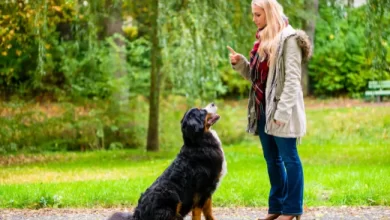
When people hear the phrase “How to House Train Your Dog,” it usually brings up two strong feelings: the excitement of welcoming a new furry friend and the anxiety of dealing with those first indoor accidents. Whether you’re starting potty training with a playful puppy or helping an adult dog learn new habits, house training is one of the most important steps in building a happy home together. Every pet parent dreams of a clean, accident-free house, but the process can feel overwhelming without the right guidance. The good news? With a little patience, consistency, and positive reinforcement, you can teach your dog where and when to go—no matter their age or background.
In this easy-to-follow guide, we’ll share expert advice about how to house train your dog and step-by-step potty training tips, and create training strategies that work for both puppies and adult dogs. You’ll learn how to spot your dog’s signals, set up a routine, and handle setbacks with confidence. Ready to enjoy a cleaner home and a stronger bond with your pup? Let’s dive into how to house train your dog and make the process as smooth as possible for you both.
Step 1: Understand Your Dog’s Needs and Behavior
Why Don’t Dogs Instinctively Know Where to Go?
Dogs, especially puppies, do not naturally know where they should go to the bathroom in a human home. In the wild, dogs pick spots away from their sleeping and eating areas, but they do not understand the rules of a house right away. Your puppy needs to learn what you want from them, and this takes time and patience.
Be Patient and Learn Normal Dog Behavior
- Every puppy is different. Some learn quickly, while others take more time.
- Puppies have small bladders and cannot hold their pee for long, especially when they are very young.
- It is normal for puppies to have accidents while they are learning. This does not mean they are being “bad”—they are just still figuring things out.
- Dogs do not understand punishment after the fact. If you scold your dog for an accident that happened earlier, they will not know why you are upset.
- Positive reinforcement, like treats and praise, helps your dog learn faster and makes training a happy experience for both of you.
Step 2: Schedule a Veterinary Checkup
Why a Vet Visit Matters for House Training
Before you get too far with house training your dog, it’s important to make sure your dog is healthy. Sometimes, if your dog is having trouble learning where to go potty, there could be a medical reason behind it. A trip to the vet can help you rule out health problems that might make house training harder.
When to See the Vet
- If your dog keeps having accidents in the house, even when you’re following a training plan
- If your puppy pees many times an hour, or seems to go suddenly without warning
- If your dog seems to be in pain, strains to pee, or has blood in their urine
- If your dog’s accidents started suddenly after being house trained
These signs could mean your dog has a urinary tract infection or another health problem. It’s best to have a vet check your dog to be sure.
How Health Affects House Training
- Dogs with medical problems may not be able to hold their pee or poop
- Some illnesses make dogs drink more water, so they need to go out more often
- Pain or discomfort can make it hard for your dog to learn new things
When your dog feels good, they can focus better and learn faster. Healthy dogs are much easier to train.
What Happens at the Vet Visit
- The vet will do a full checkup to look for any health issues
- They may test your dog’s urine or take a stool sample
- The vet will talk to you about your dog’s diet, weight, and behavior
- If your dog needs medicine, the vet will give you instructions
Regular checkups also help catch other problems early, like dental issues or parasites, which can affect your dog’s comfort and training success.
Tips for a Successful Vet Visit
- Bring a list of your dog’s symptoms and any questions you have
- Tell the vet about your house training routine and any problems
- Follow the vet’s advice about treatment or changes to your training plan
Step 3: Establish a Consistent Routine for House Training Your Dog
Creating a steady daily routine is one of the most important parts of house training your dog. Dogs learn best when they know what to expect and when things happen at the same time every day. This helps them feel safe and makes it easier for them to understand where and when they should go to the bathroom.
Why Consistency Matters
- Dogs thrive on routine. When things happen at the same time each day, your dog learns what is expected.
- A predictable schedule helps your dog know when it’s time to eat, play, nap, and go outside to potty.
- Consistency reduces confusion and accidents inside the house.
How to Create a House Training Schedule
Here’s how you can set up a simple, consistent routine for your dog:
Feeding Schedule
- Feed your dog at the same times every day, such as morning, afternoon, and evening.
- Regular feeding times help you predict when your dog will need to go outside, because dogs usually need to potty soon after eating.
Potty Breaks
- Take your dog outside first thing in the morning, right after meals, after naps, after playtime, and before bed.
- For puppies, take them out every 2-3 hours, since they can’t hold it as long.
- Always use the same outdoor spot for potty breaks. This helps your dog remember where to go.
- Watch for signs your dog needs to go, like sniffing, circling, or whining, and take them outside right away.
Naps and Bedtime
- Let your dog nap at the same time each day if possible.
- Take your dog outside right after they wake up from a nap and before bedtime.
Playtime
- Schedule regular play sessions, and always take your dog outside after playing. Physical activity can make them need to go potty.
Sample Daily Routine
Here’s an example of a daily schedule for a puppy:
- 6:00am – Wake up and potty break
- 6:30am – Breakfast
- 7:00am – Potty break
- 7:30am – Playtime
- 8:00am – Potty break
- 8:30am – Nap time
- 11:30am – Potty break after nap
- 12:00pm – Lunch
- 12:30pm – Potty break
- 1:00pm – Nap time
- 3:00pm – Potty break after nap
- 3:30pm – Playtime
- 4:00pm – Potty break
- 6:00pm – Dinner
- 6:30pm – Potty break
- 8:00pm – Last water and potty break
- 8:30pm – Bedtime
You can adjust the times to fit your own schedule and your dog’s needs.
Tips for Sticking to the Routine
- Use the same words and cues every time you take your dog outside, like “potty” or “be quick.” This helps your dog understand what you want them to do.
- Reward your dog with praise or a treat right after they go in the right spot. This positive feedback helps them learn faster.
- Make sure everyone in your family follows the same routine and rules. This avoids confusing your dog.
The Benefits of a Consistent Routine
- Dogs learn faster and have fewer accidents when they know what to expect each day346.
- A routine helps your dog feel secure and confident.
- It makes house training less stressful for both you and your dog.
By following a consistent schedule for feeding, potty breaks, naps, and playtime, you’ll help your dog understand what’s expected and make house training much easier and quicker for both of you.
Step 4: Choose the Right House Training Method
When house training your dog, picking the right method is important for both you and your pet. There are three main ways people use: crate training, paper/pad training, and the umbilical cord method. Each has its own benefits and challenges. Below, you’ll find a simple comparison to help you decide what’s best for your lifestyle and your dog’s needs.
Crate Training
How it Works:
- Your dog stays in a crate (a safe, comfy box or cage) when you can’t watch them.
- Dogs don’t like to go to the bathroom where they sleep, so they learn to “hold it” until you let them out.
- You take your dog outside right after they leave the crate to go potty, then give lots of praise if they go in the right spot.
Pros:
- Helps dogs learn bladder control quickly.
- Give your dog a safe, personal space to relax.
- Reduces accidents and keeps your home clean.
- Useful for travel, vet visits, or when guests come over.
Cons:
- Some dogs may feel anxious or stressed if left in the crate too long.
- Not good for dogs with medical issues that need frequent bathroom breaks.
- Needs the right size crate—not too big or too small.
- Should never be used as a punishment.
Best For:
- People who can take their dog outside often.
- Dogs who like cozy, quiet spaces.
- Busy homes where the dog needs a safe place when unsupervised.
Paper/Pad Training
How it Works:
- You set up special pads or newspapers in a certain spot inside your home.
- Teach your dog to go potty on the pad instead of the floor.
- Useful for puppies, small breeds, or if you can’t always go outside.
Pros:
- Convenient for people in apartments or with no yard.
- Good for very young, old, or tiny dogs who can’t hold it long.
- Helpful in bad weather or if you’re gone for long hours.
Cons:
- Can be harder to teach your dog to go outside later.
- Pads need to be changed often to keep the area clean and odor-free.
- Some dogs may chew or play with the pads.
- Not as fast as other methods for full house training.
Best For:
- Apartment dwellers.
- Owners with limited outdoor access.
- People with very young, old, or small dogs who need frequent bathroom breaks.
Umbilical Cord Method
How it Works:
- Your dog is attached to you with a leash (“umbilical cord”) as you move around the house.
- You watch your dog closely and take them outside as soon as you see signs they need to go.
- Prevents accidents because your dog can’t sneak away.
Pros:
- Very effective—your dog learns quickly because you catch them every time.
- Builds a strong bond between you and your dog.
- Great for people who are home a lot and can supervise closely
Cons:
- Requires a lot of time and attention.
- You must keep your dog with you almost all the time.
- Can get tiring if you need to move around a lot or do chores.
Best For:
- People who are home most of the day.
- Dogs who need extra supervision.
- Owners who want to avoid using a crate.
How to Choose the Best Method
- Your Schedule: If you’re home a lot, the umbilical cord method or crate training can work well. If you’re gone often, paper training may be easier.
- Your Home: Apartment living may make paper training more practical. Houses with yards are great for crate or umbilical cord training.
- Your Dog: Small, young, or older dogs may need paper training. Active or anxious dogs might do better with the umbilical cord method or crate training for structure and safety.
- Your Preferences: Some people don’t like crates, others don’t want pads in the house. Pick what feels right for you and your dog.
Step 5: Supervise and Confine Appropriately
House training your dog takes patience and consistency. One of the most important steps is to watch your dog closely and use safe spaces when you cannot watch them. This helps your dog learn faster and prevents accidents in your home.
Why Supervision Matters
- When you watch your dog, you can see when they need to go outside.
- You can catch them before they have an accident in the house.
- Supervision helps you teach your dog where it is okay to go potty.
How to Supervise Indoors
- Keep your dog in the same room as you.
- Use a leash indoors to keep your dog close.
- Watch for signs like sniffing, circling, or going to the door. These signs mean your dog may need to go outside.
Using a Leash Indoors
- Clip a leash to your dog’s collar and hold it or tie it to your belt.
- This keeps your dog near you and stops them from sneaking off to have an accident.
- It also helps you build a bond with your dog.
When You Cannot Supervise
- If you are busy or need to leave the room, use confinement.
- Put your dog in a crate, playpen, or a small room with a baby gate.
- Make sure the space is safe and comfortable.
How Confinement Helps
- Dogs do not like to go potty where they sleep or rest.
- Confinement teaches your dog to hold it until you take them outside.
- This prevents accidents and helps your dog learn faster.
Tips for Successful Confinement
- Keep the crate or playpen just big enough for your dog to stand, turn around, and lie down.
- Give your dog toys or a chew to keep them busy.
- Take your dog outside as soon as you let them out of the confined space.
Step 6: Reward and Reinforce Good Behavior
Why Positive Reinforcement Matters
When you are house training your dog, it’s important to let your dog know when they do the right thing. Positive reinforcement means giving your dog something they like—such as a treat, praise, or a favorite toy—immediately after they go to the bathroom outside. This helps your dog learn that going outside is a good thing and makes them want to do it again.
How to Use Positive Reinforcement
- Always reward your dog within a few seconds after they finish going to the bathroom outside. This helps them connect the reward to the action.
- Use treats your dog really enjoys. Small, soft treats work best because your dog can eat them quickly and look forward to more.
- Praise your dog with a happy voice. You can say “Good dog!” or “Yes!” to show you are pleased.
- Some dogs love toys or playtime. If your dog likes these more than food, use them as a reward.
- Be consistent. Reward your dog every time they go outside in the beginning. As they learn, you can give treats less often and use praise more.
Tips for Success
- Keep treats handy when you take your dog outside.
- Use the same word or phrase each time, like “Go potty,” so your dog learns what you want.
- Make sure everyone in your family uses the same rewards and words for your dog.
Why Punishment Does Not Work
Punishing your dog for accidents inside the house does not help. In fact, it can make things worse.
- Punishment, like yelling or scolding, can make your dog scared or anxious.
- Dogs may not understand why they are being punished, especially if it happens after the accident. They might just learn to fear you, not what you want them to do.
- Punishment can break the trust between you and your dog. It can also make your dog hide when they need to go to the bathroom, making house training harder.
Building a Happy Relationship
By using rewards and praise, you help your dog feel safe and confident. Training becomes a fun experience for both of you. Your dog will want to please you and will learn faster when they know good things happen when they do the right thing.
Step 7: Troubleshoot Common House Training Problems
House training your dog can be tough sometimes. Even when you try your best, problems can happen. Here are common issues and simple ways to fix them. These tips work for puppies, adult dogs, rescue dogs, and dogs with old bad habits.
Common House Training Problems and Solutions
- Accidents in the Crate
- The crate might be too big. Your dog should only have enough space to stand, turn around, and lie down. If it’s too big, they might use one side as a bathroom and the other for sleeping.
- Dogs who were forced to live in dirty cages before may not mind soiling their crate. For these dogs, you may need to start crate training from the beginning and be extra patient. Sometimes, help from a trainer is needed.
- If your dog keeps getting dirty in the crate, check with a vet to make sure there’s no medical problem.
- Dog Gets Distracted Outside
- Keep your dog on a leash. Don’t let them play or get distracted by toys or other pets until they go potty.
- Ignore your dog while waiting. Don’t talk or play until they finish. If they don’t go after 10 minutes, bring them inside and try again after 10-15 minutes.
- Dog Seems Stubborn or Won’t Go
- Sometimes, it’s not stubbornness. Your dog might not understand what you want. Go back to basics: take them out often, reward them every time they go outside, and keep a regular routine.
- If your dog keeps having accidents, you might not be watching them closely enough. Supervise them or keep them in a small area when you can’t watch.
- Dog Keeps Peeing in the Same Spot Indoors
- Clean up accidents with an enzymatic cleaner. If any smell is left, your dog will want to go there again.
- Accidents When Left Alone
- Don’t give your dog too much freedom too soon. Only let them have more space after they show they can stay clean in a small area.
- If you’re gone for long periods, ask a friend or dog walker to help take your dog out.
Special Tips for Adult Dogs, Rescue Dogs, and Dogs With Bad Habits
- Adult and rescue dogs can learn just like puppies, but it might take longer
- Use the same steps as with puppies: set a routine, take them out often, and reward them for going outside.
- Don’t punish accidents. This can make your dog scared and make the problem worse.
- If your rescue dog had to go potty in their old home or crate, be patient. They may need more time to learn new habits.
- Limit alone time at first. Slowly increase it as your dog learns to hold it.
Extra Tips for Success
- Stick to a schedule for feeding and potty breaks.
- Watch for signs your dog needs to go: sniffing, circling, whining, or heading to the door.
- Always praise and reward your dog for going in the right place.
- Be patient and consistent. Every dog learns at their own pace.
With time, patience, and love, your dog will learn where to go potty. If you’re struggling, don’t be afraid to ask a vet or trainer for help.
How to House Train Your Dog
House training your dog is an important step for a happy home. It helps your dog learn where and when to go to the bathroom. With patience and the right steps, you can teach your dog good habits. Here’s a simple guide to help you get started.
1. Set a Routine
- Take your dog outside at the same times every day.
- Good times are after waking up, after eating, and before bedtime.
- Dogs learn faster when they have a regular schedule.
2. Choose a Bathroom Spot
- Pick one spot outside for your dog to use as a bathroom.
- Always take your dog to this spot.
- The smell will help remind your dog what to do.
3. Watch for Signs
- Look for signs your dog needs to go, like sniffing, circling, or whining.
- Take your dog outside right away if you see these signs.
4. Use Praise and Rewards
- When your dog goes in the right spot, praise them with a happy voice.
- Give a small treat right after they finish.
- This helps your dog learn that going outside is a good thing.
5. Supervise Indoors
- Keep an eye on your dog when they are inside.
- Use a leash or keep them in the same room as you.
- This helps prevent accidents.
6. Handle Accidents Calmly
- If your dog has an accident, clean it up right away.
- Do not punish or yell at your dog.
- Accidents are normal and part of learning.
7. Use a Crate
- A crate can help your dog learn to hold it until it’s time to go outside.
- Make the crate comfortable and never use it for punishment.
- Dogs usually do not like to go to the bathroom where they sleep.
Conclusion
To house train your dog, remember these 7 steps:
- Set a routine
- Choose a bathroom spot
- Watch for signs
- Use praise and rewards
- Supervise indoors
- Handle accidents calmly
- Use a crate
Be patient and consistent. Every dog learns at their own pace. With love, patience, and these simple steps, you can house train your dog. It is possible for every owner to succeed with the right approach!
FAQ
At what age can I start house training my puppy?
You can start house training your puppy at 8 weeks old. Puppies can learn quickly with a regular schedule, lots of praise, and patience.
How long does it take to house train a dog?
Most dogs take 4 to 6 months to be fully house trained. Some may learn faster, while others take longer, depending on age and routine.
What if my dog regresses after being house trained?
Stay calm and go back to a regular potty schedule. Reward good behavior and rule out health issues with your vet if it keeps happening.
Can older dogs be house trained?
Yes, older dogs can be house trained. Use the same steps as with puppies—be patient, consistent, and use rewards to help them learn.
How do I clean up accidents to prevent repeat offenses?
Use an enzyme cleaner to remove the smell completely. This stops your dog from returning to the same spot to go again.



